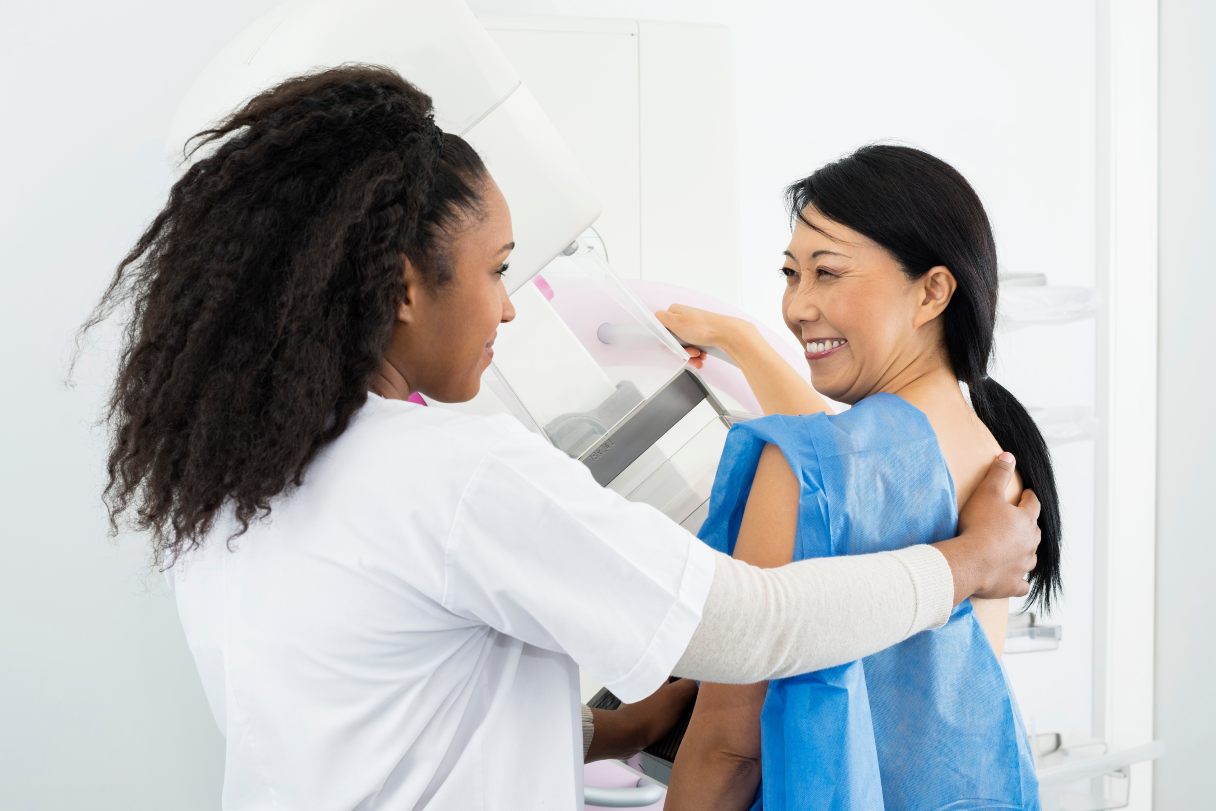You've probably heard that a breast cancer screening like a mammogram is one of the best ways to detect breast cancer. But how old should you be when you have this health screening done? And will your health insurance cover a mammogram or will you be faced with out-of-pocket costs? Get the answers to these questions and more in this guide.
What Is a Mammogram?
A mammogram is an X-ray of the breast that doctors use to look for early signs of breast cancer in the breast tissue and surrounding areas.1
You might be wondering if you need to get a mammogram if you do breast self-examinations every month — the answer is yes. A mammogram is considered the best test for detecting breast cancer early and can even help find cancer up to three years before you might feel a lump.1 Finding breast cancer early makes it much easier to treat.2
At What Age Should You Begin Mammogram Screenings?
Over the past decade or so, women's health and cancer organizations have debated the age at which you should get your first mammogram. Your doctor might suggest you begin mammography at age 40 if you have an average risk of breast cancer.2
However, some women are at a higher risk of breast cancer based on family history, personal health history, race or other factors (e.g., body weight, smoking history), as well as activity levels. If so, your doctor might suggest you get your first mammogram earlier than age 40, and/or that you get additional tests like an MRI or a breast ultrasound.3
Additional tests might cost more money if they aren't covered by your insurance. Going through these tests will also require time, patience and can cause discomfort.4 And even though breast cancer screenings are important for detecting cancer early, they can be stressful and take a toll on your mental health. Keep this in mind as you weigh the pros and cons of the mammogram age.
At the very least, you should have your first mammogram screening by age 50. Then, it's recommended that you have a mammogram every one to two years until you're at least 75 years old.2
Pros of getting mammograms at a young age
- Screening for breast cancer at age 40 can be beneficial for detecting breast cancer early.5
- It can be particularly important for Black women's mammogram age to begin at 40, since they tend to get breast cancer at a younger age than other races. Black women also are more likely to die of breast cancer than other races.5
- If you're at high risk for breast cancer — for example, you have BRCA gene mutations — talk to your ob-gyn about their recommendations for the age you should start mammograms.2
Cons of getting mammograms at a young age
- A mammogram requires a low dose of radiation, so some patients or their healthcare providers might think it's unnecessary to get the breast cancer screening before age 50.3 Overall, the benefit of screening for breast cancer outweighs the risk of low-dose radiation.
- False-positive results for breast cancer are more likely to occur in women in their 40s and 50s. That's something to be aware of before you go for your first mammogram.5
- You might need to undergo additional tests and/or even a biopsy where a sample of breast tissue is removed for testing. These other tests involve some small risks.5
- The cost of these tests, including doctor's visits and lab fees, can add up if your insurance doesn't cover them.
- Even if you have insurance, the copays and deductibles might deter a patient from going for follow-up diagnostic imaging of the breast if they had abnormal results.4
Common Types of Mammograms
There are two common types of mammograms:
- Screening mammograms are used to look for any breast changes in a woman who doesn't have breast cancer. You'll likely have at least two X-rays taken of each breast.3
- Diagnostic mammograms involve additional photos of the breast to check for any issues that were detected during a screening mammogram. This breast screening test can also give the radiologists and your healthcare team a better sense of what may be causing changes to the shape of the breast, lumps, pain, nipple thickening or discharge.3
Mammogram Cost
A diagnostic mammogram costs on average $349.6 As you contemplate your mammogram age — whether or not you are over 40 years old — for your first screening, you should take into consideration what your health insurance policy is for mammograms.
Here are some approximate costs of mammograms around the country for those with insurance and without insurance.6
Screening mammogram cost
| State | Screening Mammograms With Private Insurance | Screening Mammograms Without Insurance |
|---|---|---|
|
Texas |
$0 if over 40 |
$65 to $170 |
|
California |
$0 to $105 if over 40 |
$80 to $330 |
|
Ohio |
$0 if over 40 |
$70 to $170 |
|
Massachusetts |
$0 if over 40 |
$0 to $380 |
|
Florida |
$0 if over 40 |
$99 to $250 |
Diagnostic mammogram cost
| State | Diagnostic Mammograms With Private Insurance | Diagnostic Mammograms Without Insurance |
|---|---|---|
|
Texas |
$336 to $836 |
$638 to $1,046 |
|
California |
$265 to $1,788 |
$290 |
|
Ohio |
$300 |
$345 to $400 |
|
Massachusetts |
$500 |
$240 |
|
Florida |
$187 to $550 |
$168 to $185 |
A recent survey of more than 700 women found that when presented with the hypothetical scenario of having to pay for part or all of follow-up breast cancer imaging, 21% said they'd skip it, 59% said they would not skip it and 19% were undecided.4 Women who needed breast MRI scans were more likely to get them if their insurance had lower out-of-pocket costs, according to the report.4
Talk to your insurance company to learn more about what's covered by your health plan and your approximate out-of-pocket costs. Ask the doctors' offices about any copays and lab fees so you have an idea of what you may need to pay.
Keep these costs in mind if you're thinking about breast explant surgery.
Does a Mammogram Hurt?
Women might not get a mammogram done in the first place because they've been told the process hurts. Or, they had a mammogram done in the past and remember the experience as one that was uncomfortable and unpleasant.
A mammogram is done by compressing the breast onto plates of the mammogram equipment to spread the breast tissue apart.3 While it doesn't feel like a gentle massage, some people say the compression process and pressure is painful.1 But that pressure on the breast is needed to keep radiation levels low during the few seconds the machine is taking photos of your breasts.3
Your breasts may be more sensitive if you're about to get your period or during your period, so try not to schedule the mammogram during those weeks, if possible.1
Managing Health & Wellness Costs With the CareCredit Credit Card
If you are looking for an option to help manage your health & wellness costs, consider financing with the CareCredit credit card. The CareCredit credit card can help you pay for the care you want and need and make payments easy to manage.* Apply today and use our Acceptance Locator to find a provider near you that accepts CareCredit. Continue your wellness journey by downloading the CareCredit Mobile App to manage your account, find a provider on the go and easily access the Well U hub for more great articles, podcasts and videos.
Author Bio
Diana Kelly Levey is a freelance journalist, content marketing writer and author with more than 15 years of experience covering health and wellness.








